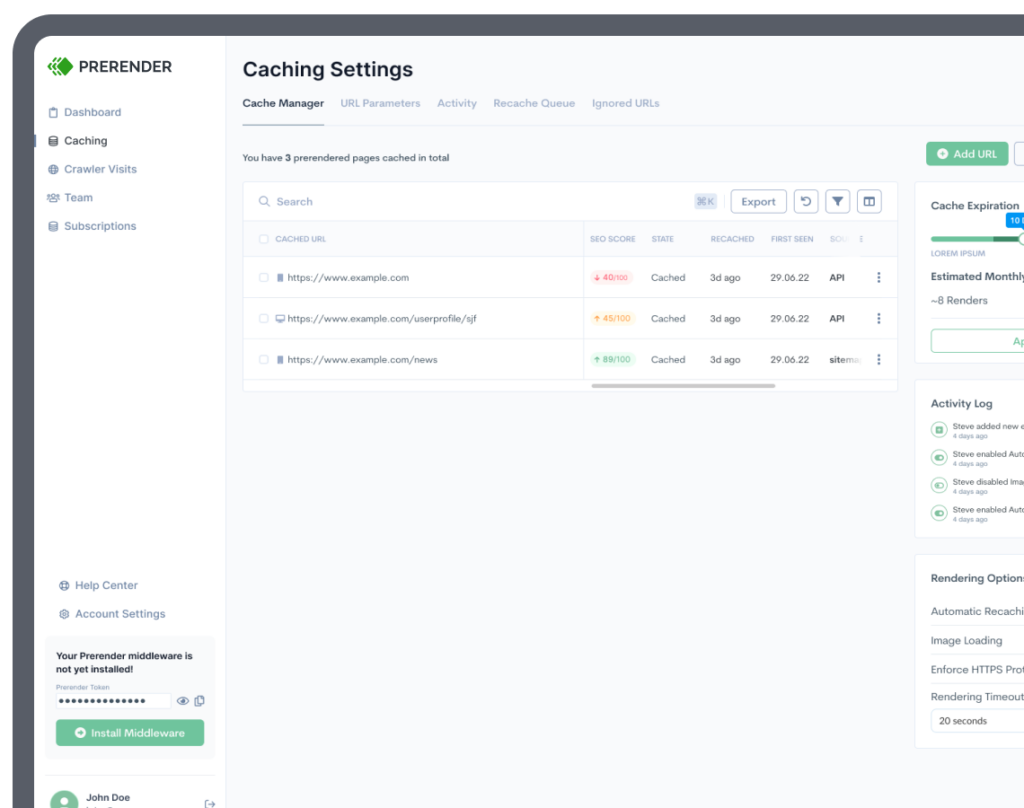Better User Experience
The Faster You Render,
The Better Your UX
Keep users focused on your content instead of on their wait time.
Google loves a good PageSpeed—but JavaScript-heavy websites often struggle to deliver. Adding images, custom fonts, and other page elements to the equation can easily exceed the optimum page load time threshold, costing you customers and revenue.
Load Your Pages in Seconds
Higher PageSpeed Scores Gives You the Upper Hand
A slow website is bad for Core Web Vital (CWV) and PageSpeed scores.
(This, in turn, leads to a poor user experience (UX) and high bounce rates.)
A recent Google study suggests that when a page load time goes from 1 to 3 seconds, the visitor bounce rate increases by 32%. And when it goes up to 5 seconds, the bounce rate rises to 90%. By improving your PageSpeed, you will reduce bounce rates, boost rankings and provide a better user experience.
Serving 100% Cached Versions
Improved Visibility and Rankings in Days
JavaScript-heavy pages that use Prerender load in an average of 0.05 seconds, while those that don’t take 5.2 seconds—that’s a 104x PageSpeed increase! Our technical SEO solution is designed to fully cache your pages, feeding the HTML version to search engine bots in a fraction of the time. See our customer case studies here.
Get on Track to Better UX!
Impress users and Google with fast loading time.
Get started with 1,000 URLs free.

Trusted by 75,000+ Brands Worldwide
Serving +2.7 billion pages to crawlers.
Nicer User Experience FAQs
Learn about Prerender, technical SEO, and JavaScript on our dedicated FAQs page.
Does User Experience (UX) Affect SEO?
Yes, UX affects SEO directly. Google uses user experience (UX) signals to determine the quality of your site and compare it against other websites that compete for the same queries. Because Google’s goal is to provide the best solution for its users, poor user experience will hurt your rankings.
Is User Experience (UX) a Ranking Factor?
In short, yes, UX is a ranking factor. According to Google’s team – “Google’s core ranking systems look to reward content that provides a good page experience.”
Factors like page load speed, mobile-friendliness, and ease of navigation contribute to a positive user experience, and Google prioritizes sites that offer this to ensure high-quality search results for users.
In other words, everything that helps you deliver a better user experience will help you rank higher in the search engine result pages (SERPs).
How Does Google Measure User Experience?
Google uses three main signals to understand the user experience quality of your site:
- HTTPS – whether or not you’re using HTTPS.
- Mobile usability – responsiveness, text size, interstitial content, etc.
- Core web vitals – a real-world measurement of loading performance (LCP), interactivity (FID), and visual stability of a page (CLS).
When your site meets Google’s standards of ‘good’ page experience, it’ll reward you with a higher chance of ranking on the first page, and it’ll be up to your content to determine whether or not you can land on this prestigious position.
Learn how to pass the core web vital test and improve your page’s mobile experience.
Does JavaScript Affect My Page Experience?
JavaScript has a big impact on your website’s core web vitals (CWVs) scores and mobile performance of your website. On average, mobile devices take 221% seconds longer to load JavaScript compared to desktops, and the CWVs scores are lower for JS-heavy sites because of the extra step Google has to take to render your content.
This is one of the biggest challenges of optimizing JavaScript sites for search engines.
How Does Prerender Improve Page Experience?
Prerender downloads, renders, and caches a snapshot of your pages in advance of a search engine’s request, allowing Prerender to deliver the ready-to-index snapshot in 0.03 seconds on average. And because it’s fully rendered, Google can process it in record time, achieving near-perfect core web vitals scores. All contribute to improving the overall page experience.
Try Prerender for free for the first 1,000 renders.
Want to learn more about prerendering? See our prerendering resources here.
